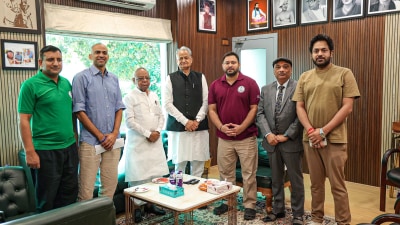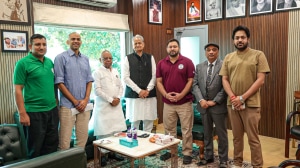Massage Message
SINCE it’s virtually impossible to de-link stress from urban life, all sorts of spas, oxygen bars and relaxation centres have cropped u...

SINCE it’s virtually impossible to de-link stress from urban life, all sorts of spas, oxygen bars and relaxation centres have cropped up in the major metros. Competing with these modern age healing techniques is the age-old Kerala massage, renowned the world over for its ability to activate the nerves and revitalise and renew the weary body. Its seeming accessibility, however, is misleading: Ayurvedic neurotherapy, of which massages are but a part, is a highly specialised science.
What is Ayurvedic massage?
Following the basic Ayurvedic belief in the integrated body mechanism, an Ayurvedic therapist can activate or de-activate organs through pressure on the nerve channels to stimulate or depress the blood, other body fluids and the nerves so as to restore the balance. ‘‘The ayurvedic massage is a complex series of therapeutic steps taken to flush out the toxins. It is a precondition of Panchkarma or five-action therapy. The body rejuvenates completely only after massage therapy and the panchkarmas,’’ says Dr R P Parashar, a Delhi-based Ayurvedic physician.
How is an Ayurvedic massage different from others?
Trained masseurs perform oil massage or Ahiyanga, a long process aimed at releasing energy stored in the body tissues. The massage stimulates blood circulation and aids in the release of toxins. ‘‘The whole process is undertaken to loosen the excess doshas (toxins) and direct them towards the organs of elimination — the mouth, for the upper part of the body, and the anus, for the lower part of the body,’’ says Dr J K George.
What are the kinds of Ayurvedic massages?
Shirodhara is a treatment in which warm herbal oil is allowed to drip onto a forehead to relax the nervous system and balance various elements that control the brain. A variation, called Sheerdhara, uses milk instead of oil to treat hypertension. Yet another version is the Sirovasti, in which a special cap is filled with medicated oils and placed on the head for about half-an-hour to treat migraines, sinusitis, facial paralysis and deafness.
Which kind of massage would be right for me?
That depends on why one is undertaking the massage. If the aim is simply relaxation, a simple massage followed by steam would be enough, says Dr Renu Batra, a Delhi-based Ayurvedic physician. If the aim is detoxification and rejuvenation of the body — there are 80 kinds of vatha-rogas, including nervous system disorders, in which massages can be therapeutic — the revitalisation process needs the massage to be followed up with the panchkarmas: Vaman (for respiratory diseases), Varachan (for intestinal disorders), Anuvasanbasti or Neruvanbasti (for urinary tract and gastro-intestinal disorders) and Nasyakarma (to relax the nerves).
Do massages follow a course?
While massages can be localised or for the whole body, the procedure has to continue for about 21 to 25 days and for 30 to 40 minutes daily. The massage has to be followed by a medicated steam bath. One word of warning: Only Ayurvedic professionals, trained in anatomy and medicinal processes, are qualified to give massages.
|
PRECAUTIONS FOR AN AYURVEDIC MASSAGE Ayurvedic massages should not be undertaken when: |






- 01
- 02
- 03
- 04
- 05

























